During one of my many travels through abandoned insane asylums, I stumbled upon a forgotten object that now calls my antique armoire home. Rockland County Psychiatric Center holds a special place in my heart as it’s one of the first abandoned insane asylums I’ve ever explored. But its history is what enchanted me long before I stepped foot onto its soil, and I’m ecstatic that I was able to explore its beauty on multiple occasions.
Established in 1927, Rockland County Psychiatric Center can be found within a barrier of birch and evergreen trees on the backroads of New York. The active mental hospital, which only treats severe cases of schizophrenia and manic depression, sits atop the hill surveying its decaying predecessor. The hospital’s gray cement buildings with secured windows dazed and entranced me the moment I pulled up to them. Two iron gates with the letter “R” written in cursive solidified the hospital’s antique feel. I wasn’t sure what to expect as I walked along the vacant road, but Rockland’s past gave me a glimpse into what used to lurk within its shadows..
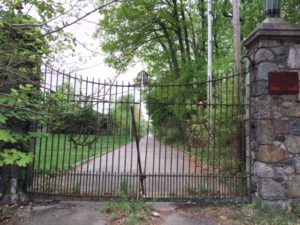
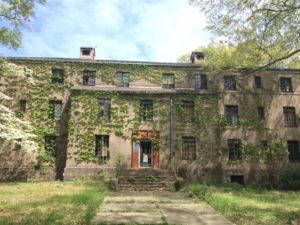
At one point, it housed over 9,000 patients, and the growing facility demanded self-sustainable outlets such as a power plant and farm. The patients worked on the farm for occupational therapy, and at the same time, they enjoyed much needed time out of their cell-like rooms. The child’s daycare still stands with all the essentials for adolescent play and learning. Its shell resembles that of a decaying building, but its chafing innards are painted with vibrant murals of Disney characters and familiar childhood cartoons. Rattles, plastic blocks and board games are just some of the items that can be found scattered across the grimy floors. Then there’s the famous pink hallway with a little girl’s bike sitting in the midst of the eeriness. The children’s ward leaves the visitors chilled to the core.
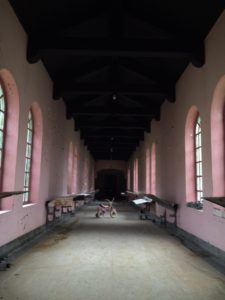
The bowling alley and recreational center at the heart of the campus provided proactive and stimulating treatments for Rockland’s patients. The shelves are still full of bowling shoes, and the original bowling balls and pins are available for a quick game. But these more positive areas of Rockland County Psychiatric Center were soon overshadowed by their unethical procedures. As with any insane asylum in the early 1900s, Rockland began implementing electroshock therapy, insulin shock therapy and prefrontal lobotomies as an attempt to cure their patients of their mental ailments. It shouldn’t come as a surprise that this now-abandoned facility is said to be crawling with paranormal activities. And although I personally haven’t experienced anything out of the ordinary, I like to think that the spirits of Rockland County Psychiatric Center brought me to this forgotten item that I cherish.
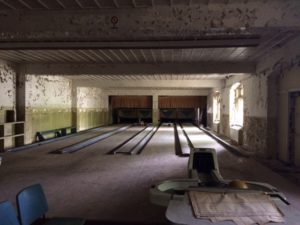
I had just finished exploring the daycare and living quarters when a patient from the current psychiatric hospital attempted to escape into one of the abandoned buildings. The mental health security swarmed him, and I naturally retreated into the tunnels. As I ventured through the scarcely lit passageway, I stumbled upon a room full of medical and laboratory equipment. Glass slides, graduated cylinders, beakers, flasks, patient charts, lung x-rays were all scattered about this small, cave-like room. I spent nearly an hour in a dingy, damp basement rummaging through the treasure chest of abandonment. Off to the side, almost waiting for me, was an Erlenmeyer flask atop a metal shelf. I climbed over cardboard boxes filled with cultures and documents until I got my hands on it. Its fat bottom and slender neck sat perfectly in my palm as I examined it. It was filthy to say the least, but I didn’t mind. I was holding a piece of sinister history. With the grime caked onto my hands I took everything out of my backpack and cushioned the flask inside before exploring the rest of the tunnels. I took one last look into this vortex of abandonment, glanced at all of the strange lab equipment, and questioned their existence. I wondered why a psychiatric hospital needed a plethora of laboratory equipment and set out to discover why.
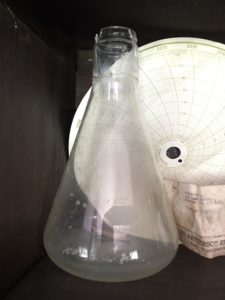
Upon arriving home I cleaned up my souvenir, cut some lilacs from my bush, and placed them inside my new, curious vase. With the scent of lilac in the air, I began researching just what insane asylums used laboratory flasks for, and much to my surprise, I found nothing. This lack of information puzzled me and only made me suspicious of Rockland’s intentions for their patients. My first thought went directly to unethical and secret experiments conducted in the basement at nightfall, but I needed to be more realistic if I wanted solid answers.
The Erlenmeyer flask served a purpose mainly in biology and chemistry, but that still didn’t tell me why I found it within the tunnel of a mental hospital. I remembered that there were glass slides with cultures on them and chest x-rays, which made me think that that they may have needed it to measure treatments of sorts, or the flask could have aided to the testing process. And just like that I found a small hit. Erlenmeyer flasks were used in cell cultures and were ideal for heating and analyzing solutions. In regards to the cultures I discovered, Erlenmeyer flasks were used in growing organisms that required a large surface-area-to-volume ratio, and more specifically, the Wikipedia page that provided me with this tiny bit of information states: “Erlenmeyer flasks used in cell culture are sterilized and may feature vented closures to enhance gas exchange during incubation and shaking.” Glass slides and petri dishes with cultures from however long ago seemed to cover one section of the floor in that room, and it was obvious that Rockland treated their patients for health issues other than their mental illnesses. But that I couldn’t find any concrete information linking these instruments and tools to insane asylums frustrated me and pushed me to want more information.
After further searching, I found more possible explanations for this flask, one of which was insulin shock therapy. Insulin, introduced in 1927, was injected into patients to lower blood sugars to induce a coma-like state so that the brain would lose consciousness. Basically, the selected patients were injected with a high, almost lethal, dose of insulin to put their brains into shock. Large fluctuations in insulin levels were believed to have a drastic effect on the brain’s functionality. Many patients experienced seizures before and after the treatment as well. Some of the other side-effects included twitching, moaning, rolling, and thrashing around. The process of insulin shock therapy took a more severe turn, as described in a shock therapy summary by britanica.com: “In general, treatments are given three times a week for a period ranging from two to six weeks; some acutely disturbed patients, however, have been given as many as two or three treatments in a single day.” A patient’s memory deteriorated over time, ultimately leaving them confused and disoriented after the procedure was administered. I understand that mental illness treatment was at still at its budding stage, but I can’t help wondering why these doctors felt it was safe and necessary to alter these patients’ minds in such a dramatic and harsh way.
It broke my heart to learn that all those patients unwillingly endured such horrendous treatments in an effort to cure them. So now one question remained surrounding my laboratory flask: could it have been used as an instrument in the process of insulin shock therapy? The more I thought about the information that I stumbled upon, the more I realized my flask very well could have aided in this monstrous procedure.
I couldn’t be more thrilled that I now have some insight as to what my flask was used for. It’s unsettling to think about all of those objects still sitting in the darkness, but I’m sorrowfully reminded that Rockland County Psychiatric Center will soon be demolished. Rockland’s demolition adds yet another layer to the sadness that surrounds abandoned insane asylums. But I’m glad I was able to take a piece of Rockland’s past with me.
The history of mental illness is menacing and one that should not be forgotten. My journeys through its corridors will last me a lifetime, which means I will be collecting countless relics from insane asylums. This flask has become a vase for my spring and summertime flowers and a representation of what patients of what mental hospital went through.
Gabrielle Frulla
Associate Editor
References:
The editors of Encylcopedia Britanica, Shock Therapy Psychiatry, May 31, 2013, https://www.britannica.com/science/shock-therapy-psychiatry#ref145472.
Erlenmeyer Flask, https://en.wikipedia.org/wiki/Erlenmeyer_flask
